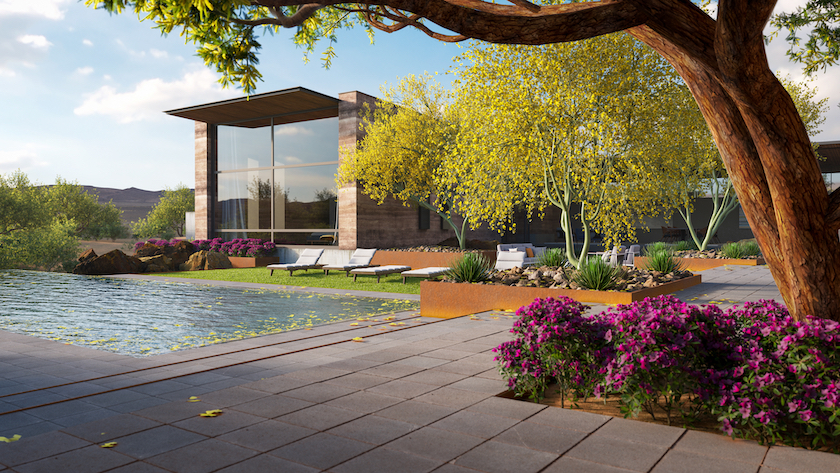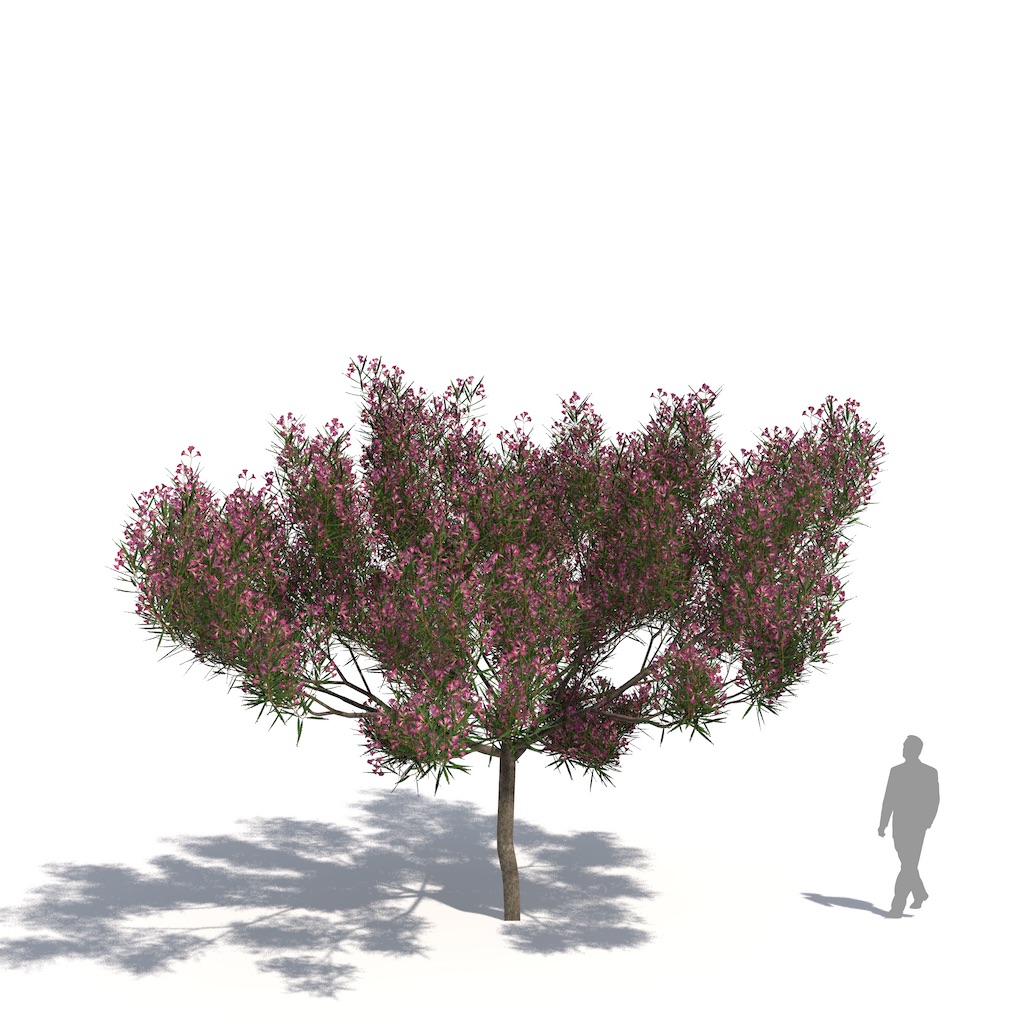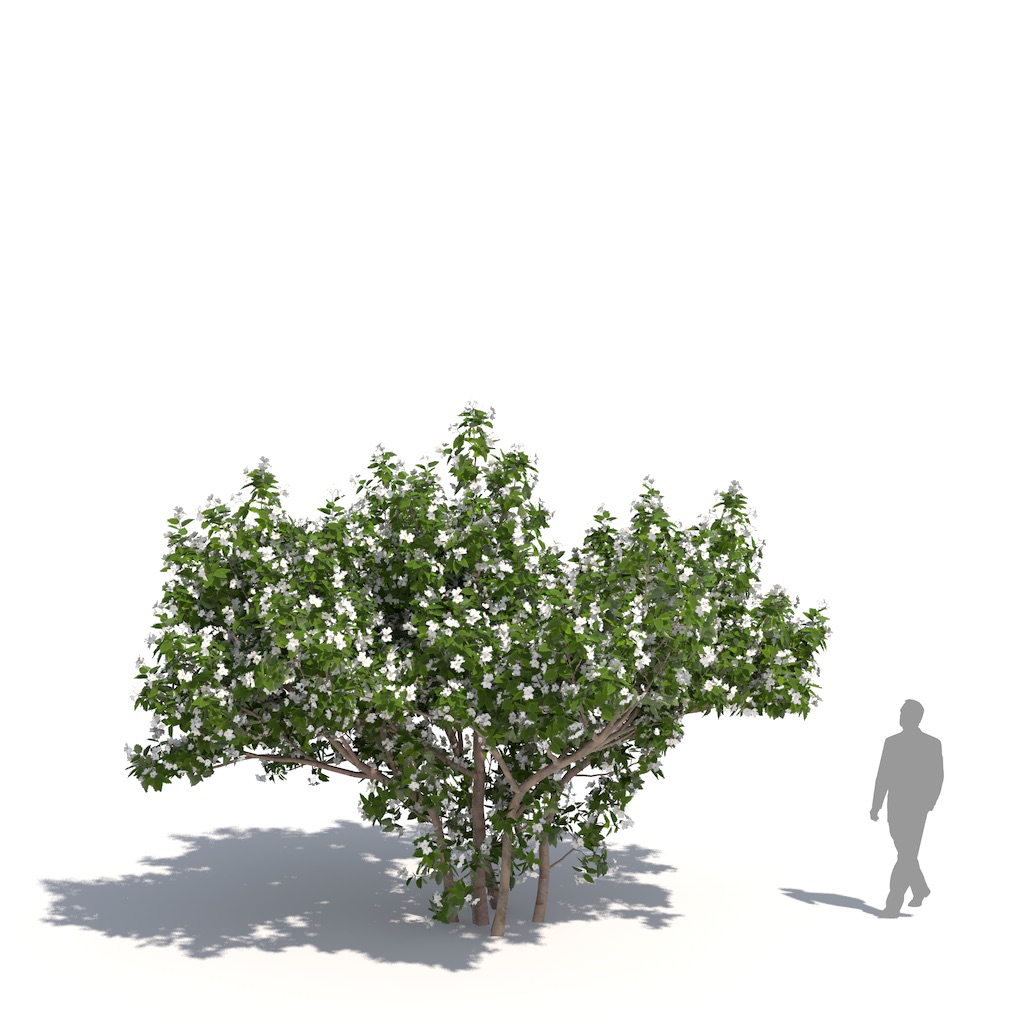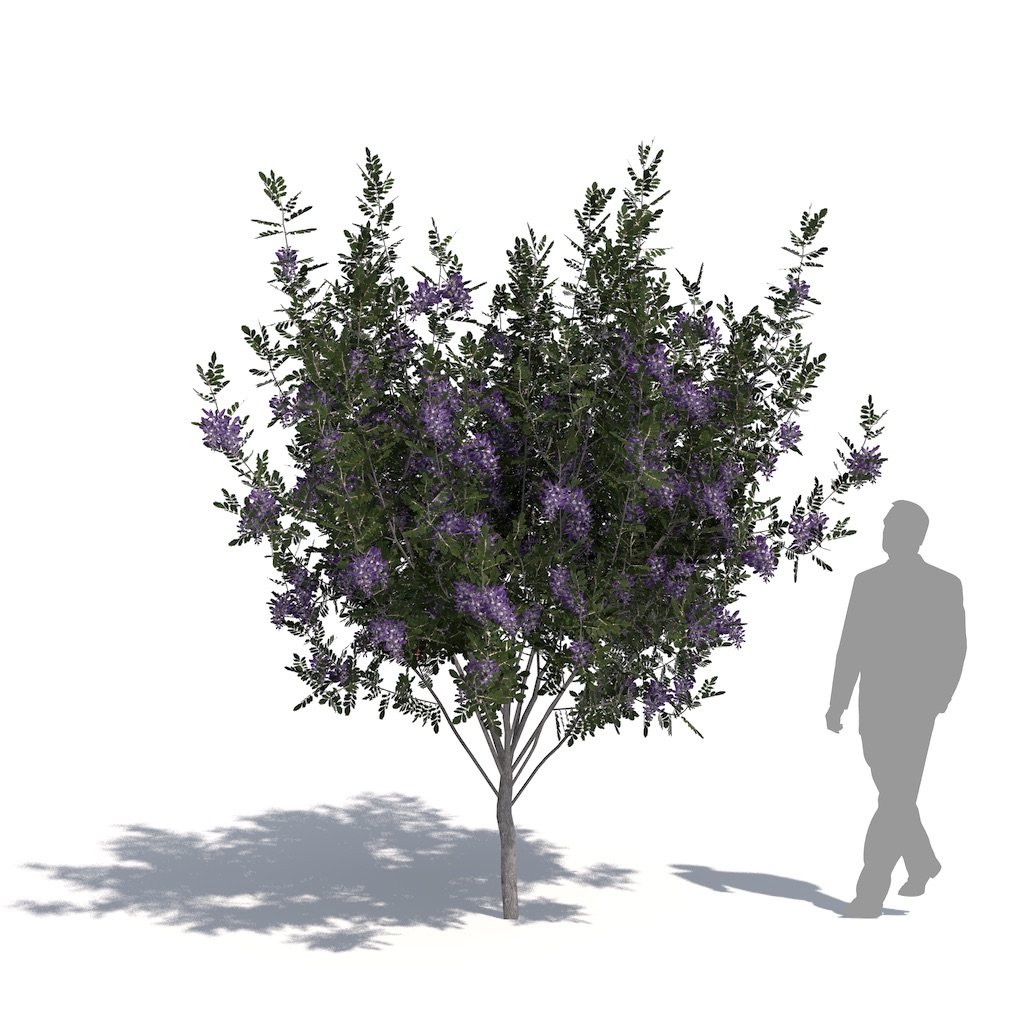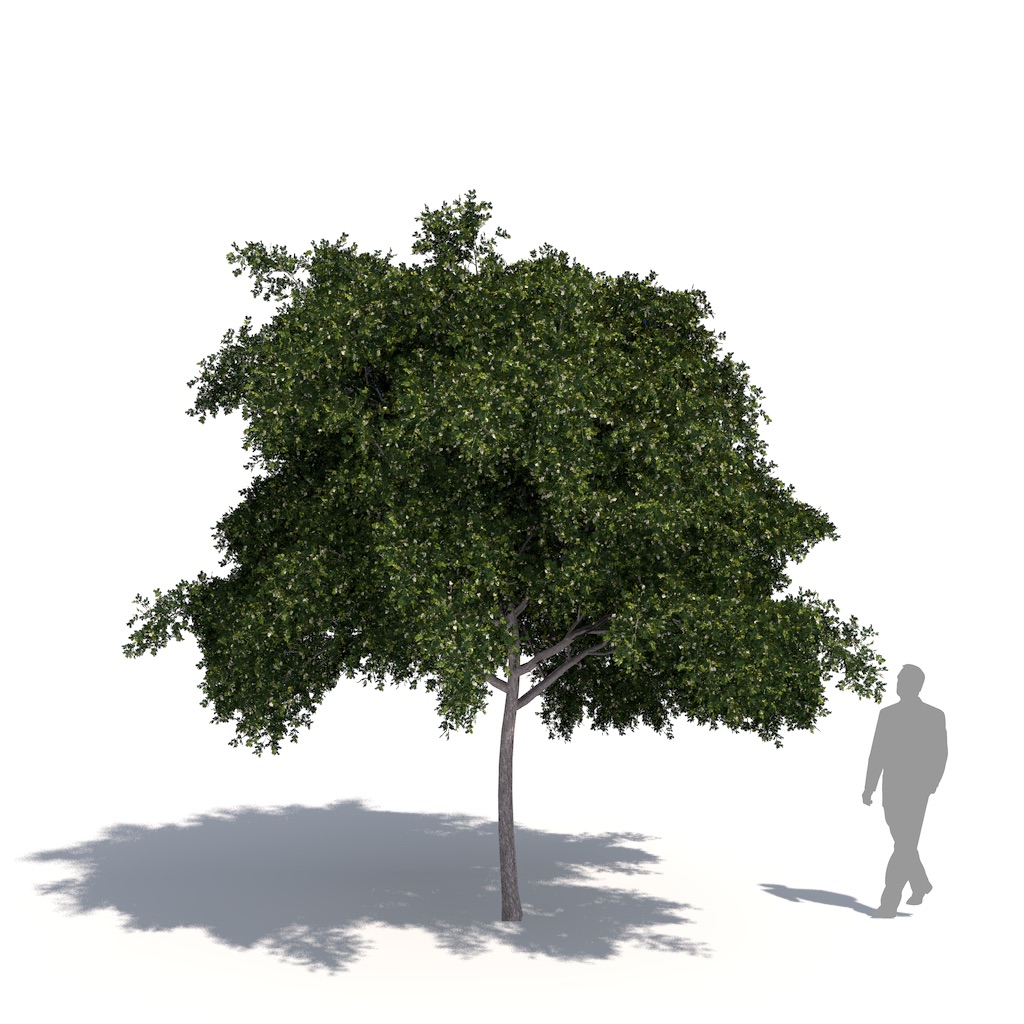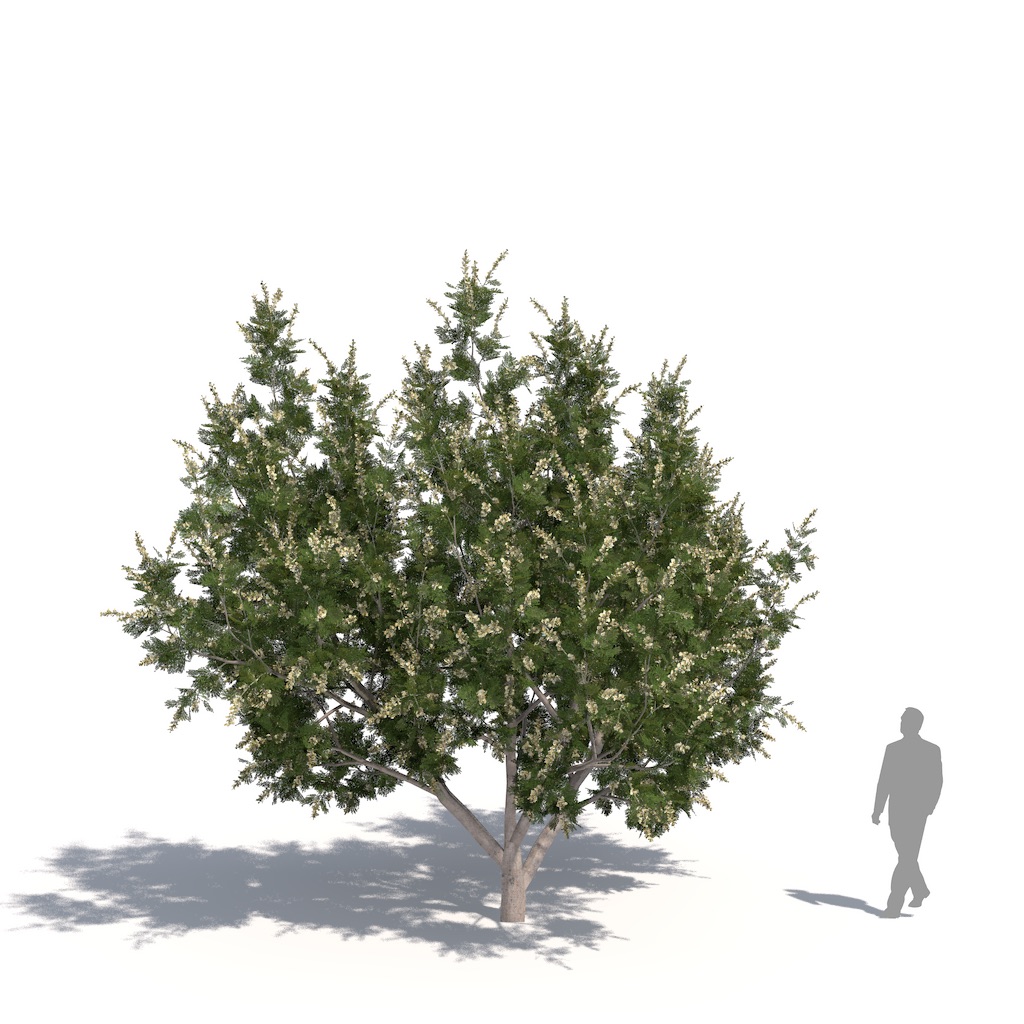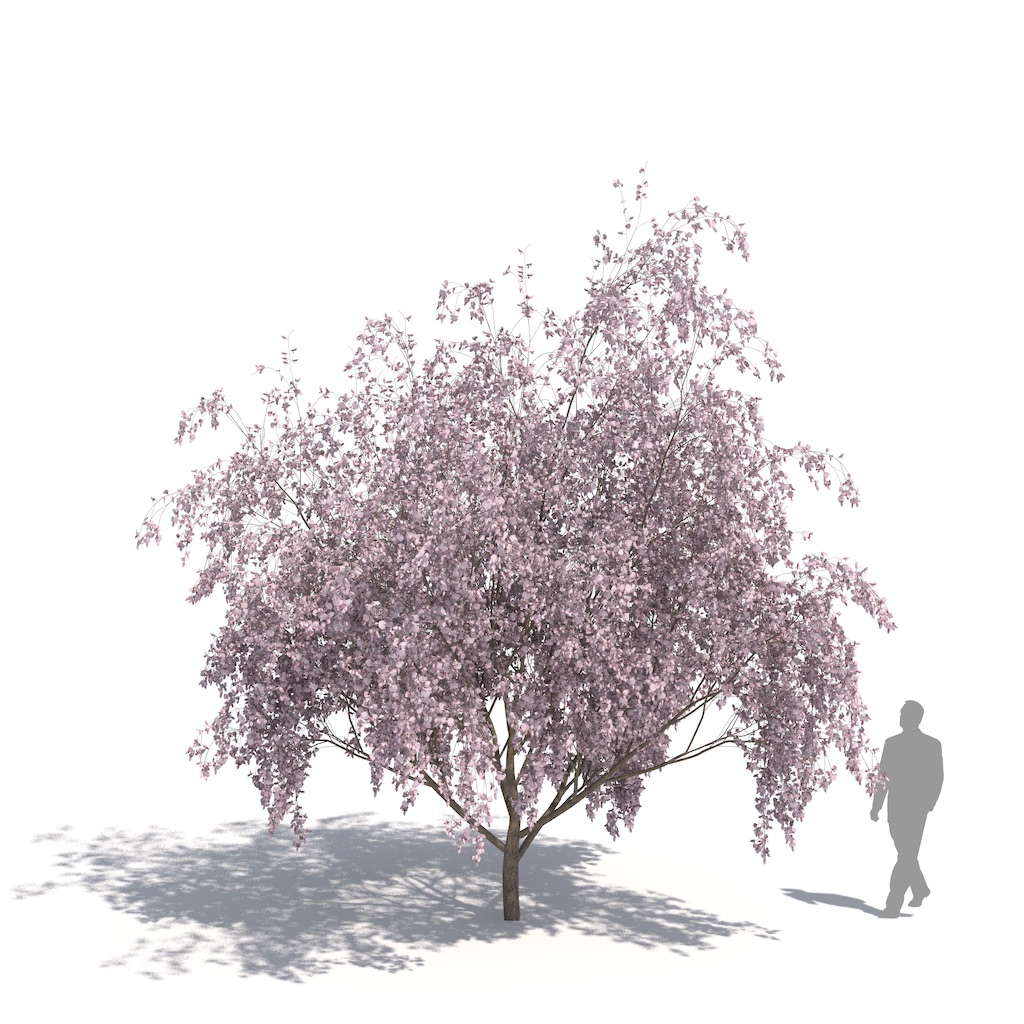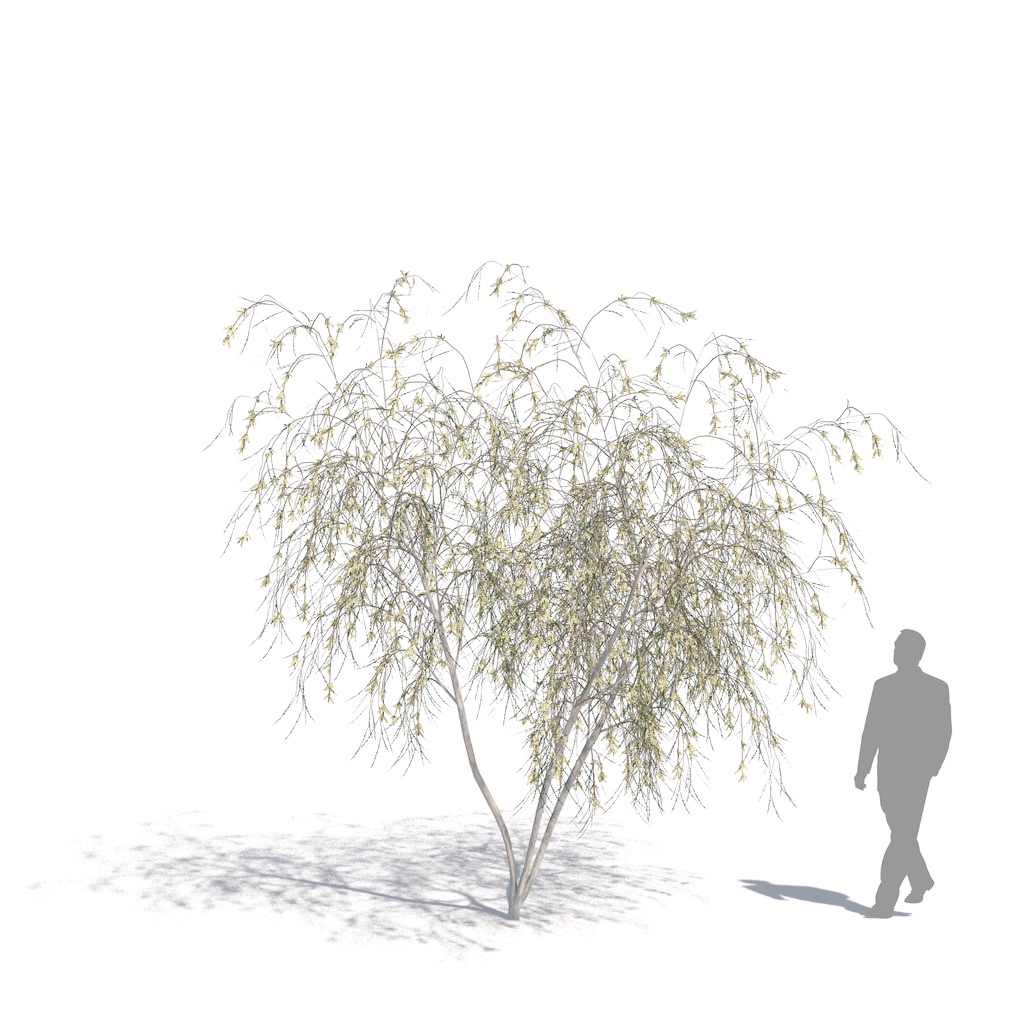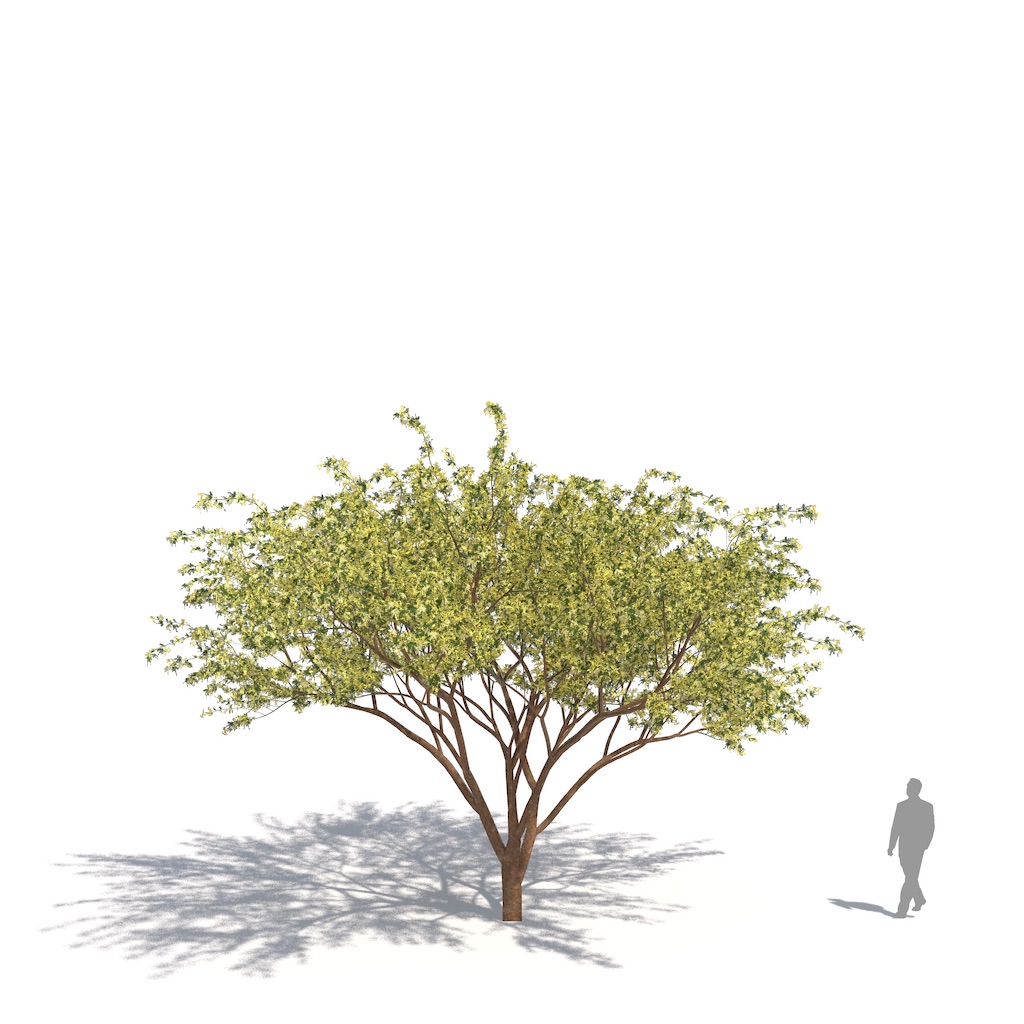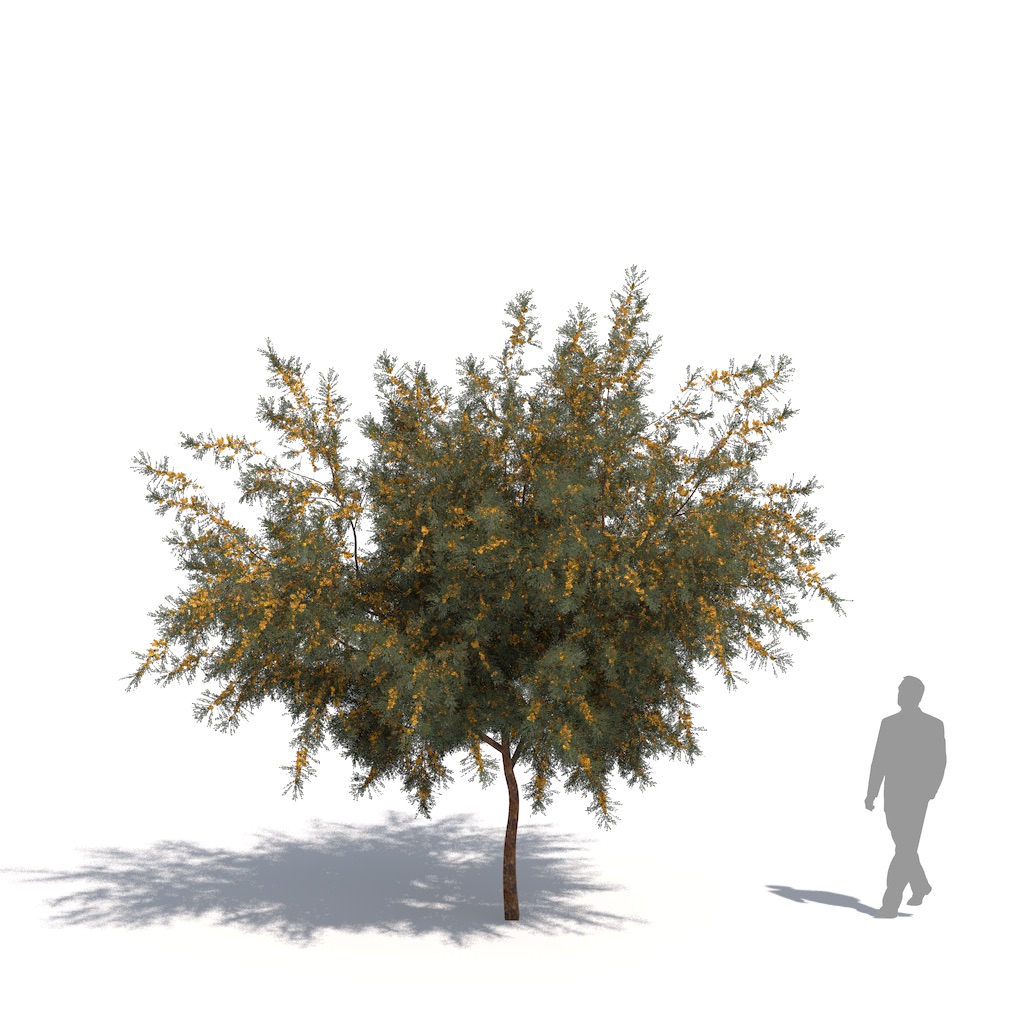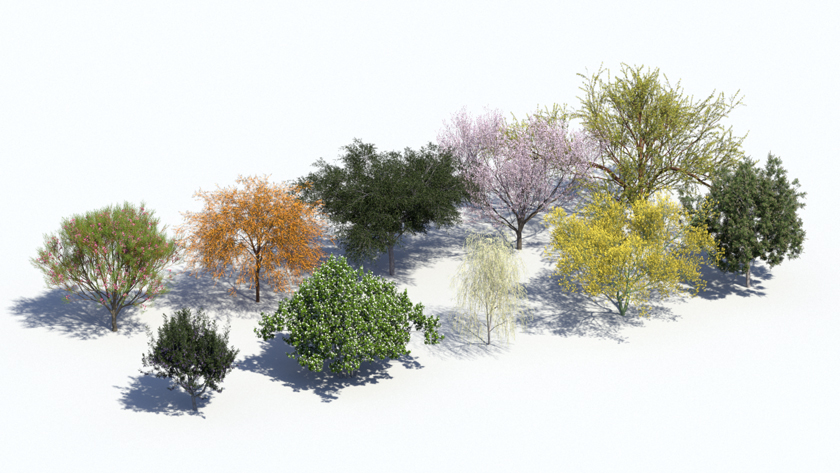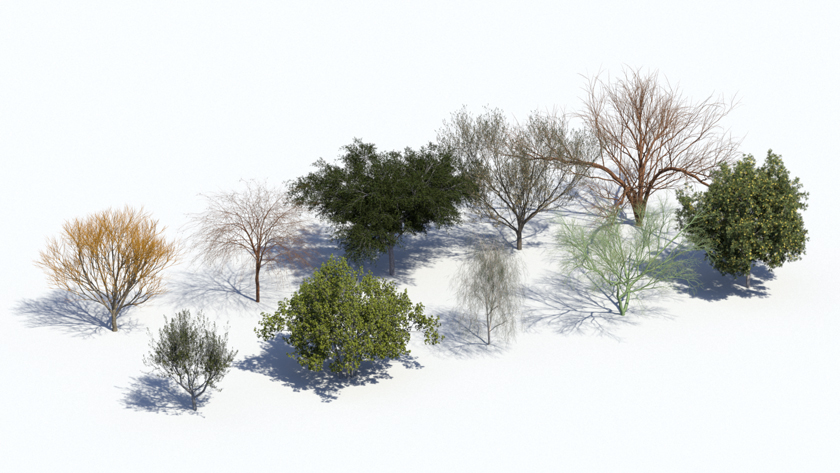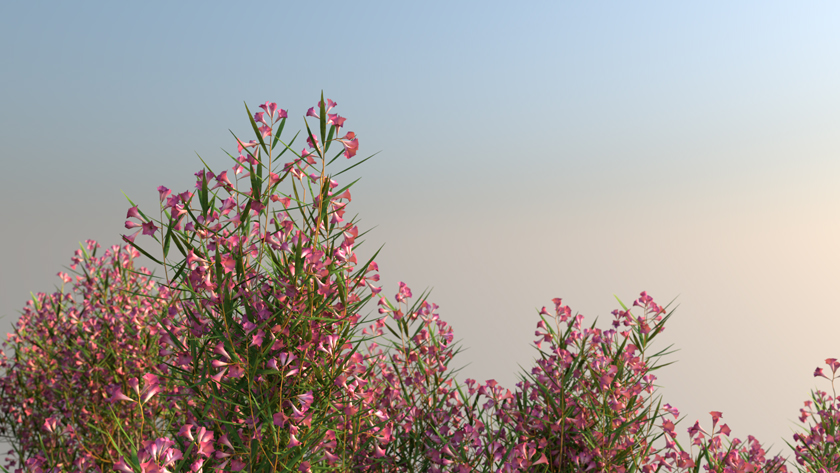Description
Arizona Desert Garden (artwork by Terry Pisel, Try Design, using SketchUp, V-Ray, Laubwerk Plants, including Kit 14).
LAUBWERK PLANTS KIT 14 – SUBTROPICAL DESERT TREES
The following 10 tree species are included in the Plants Kit 14. Each species comes in 36 variations per species, i.e. 3 variants, 3 ages and 4 seasonal aspects, for a total of 360 models per Kit.
BURGUNDY DESERT WILLOW
Chilopsis linearis ‘Burgundy’
Deciduous shrub or small tree with an irregular, rounded or umbrella-shaped, spreading crown, and fairly loose, open branching. Smooth grey bark when young, developing rough fissures with age. Willow-like light-green leaves. Large, showy, trumpet-shaped, orchid-like, fragrant burgundy flowers. Blooms appear in terminal clusters from mid-spring through fall. Long bean-type seed pods that persist on branches during winter. The wild plant species is commonly seen in washes and along riverbanks. Cultivated for its large, showy flowers, graceful, airy structure, and tolerance of hot, dry climates. It attracts birds and butterflies and is also fire defensible.
TEXAS OLIVE
Cordia boissieri
Evergreen shrub or small tree with a symmetrical round crown. Typically multi-trunked, with attractive brown bark. Ovate, green-silver alternate leaves. Trumpet-shaped white flowers in terminal clusters appear year-round, if enough rainfall or irrigation is available. Otherwise, the showy blossoms with yellow throats appear from late spring to early summer. The olive-like fruits are ovoid fleshy drupes, first green, then ripening to a creamy white, relished by birds and other wildlife. Classy tree with very showy white flowers that attract butterflies and hummingbirds.
TEXAS-MOUNTAIN-LAUREL
Dermatophyllum secundiflorum
Evergreen shrub or small-to-medium-sized tree with a symmetrical, narrow upright or round crown. Usually multi-trunked, and rarely with a straight trunk, with fissured dark-grey to black bark. Dense glossy dark-green compound leaves, composed of leathery leaflets, rounded on the ends. Pendulous clusters of very fragrant violet-blue flowers in spring. Semi-woody pods with deep orange poisonous seeds. Popular ornamental plant due to its showy flowers and orange seeds.
TEXAS EBONY
Ebenopsis ebano
Slow-growing, evergreen to semi-deciduous tree with a dense, spreading crown. Smooth grey bark when young, becoming rough and fissured with age. Young branches extend in a characteristic zig-zag pattern. Lush, dark-green foliage, pinnate compound alternate leaf. Small musty-fragranced creamy-yellow puff-ball flowers in late spring to summer. Large brown seedpods. Cultivated in xeriscaping for its dense foliage and fragrant flowers, which strongly attract bees.
TENAZA ‘SIERRA SPARKLER’
Havardia pallens ‘Sierra Sparkler’
Semi-deciduous, fast-growing tree with an upright form, and an almost columnar growth habit. Thin, grey to reddish bark, which breaks into small flakes. Small, light-green compound leaves. Mimosa-like fragrant fluffy cream blossoms after rains in late spring to summer, which attract bees. Reddish-brown seed pods. Leaves resemble those of Sweet Acacia, producing an open canopy and filtered shade. The cultivar was selected for more flowers and fewer seed pods.
DESERT IRONWOOD
Olneya tesota
Evergreen to semi-evergreen, slow-growing, large shrub to single-to-multi-trunked tree, with a widely-spreading crown. Silvery-grey bark, which becomes rough with age. Bluish-green, pinnately compound leaves. Drops leaves before bloom and leafs out again during summer monsoons. Purple and pale-pink-to-white flowers, which bloom in late spring to early summer. Light-reddish-brown seedpods. Trees are a beautiful and distinctive light-purple color when in full bloom. The wood is hard like iron and very dense, making it unusually heavy.
PALO BLANCO TREE
Mariosousa willardiana
Small-to-medium-sized slow-growing semi-evergreen tree with an airy graceful upright weeping habit and delicate open branching, slender when young but spreading elegantly with age. Distinctive smooth bark, white to reddish-yellow, peeling off and papery. May drop its grey-green leaves in a drought or cold spell. The lengthy needle-like leaf stalks remain prominently after the small leaflets drop, and hang gracefully from thin branches. Fragrant creamy-white flower spikes occur in late spring to summer, and occasionally throughout the year, followed by flattened seed pods. Wonderful visual accent tree with a picturesque silhouette, attractive bark, low maintenance requirements, and drought and heat resistance.
DESERT MUSEUM PALO VERDE
Parkinsonia ‘Desert Museum’
Rapidly growing, drought-deciduous large shrub or small tree with a sturdy, upright branching habit. Attractive smooth rich-green stems and branches. Small bright-gray-green foliage, leafing out after rainfall. Brilliant masses of pea-like yellow blossoms appear in the spring for a dramatic display, and again intermittently into the summer if given extra water. It offers an unusual green-blue silhouette in gardens, and delicately-patterned light shade over patios. The tree was hybridized at the Arizona Sonora Desert Museum in Tucson, and is a genetic cross between Parkinsonia microphylla, Parkinsonia florida, and Parkinsonia aculeata.
VELVET MESQUITE ‘AZT’
Prosopis velutina ‘AZT’
Small-to-medium-sized deciduous tree with short, forking trunk and open, spreading crown of crooked branches. Smooth reddish-brown young bark, with rough dark-brown trunk and older branches, while the young green branches are photosynthetic. Soft feathery dark-to-dusky-green foliage, with paler undersides. Bipinnately compound alternate leaves, which fold closed at night. Drooping greenish-yellow catkins in late spring, and with summer rains. Long, straight or slightly curved, straw-colored seed pods. Remarkable, uniquely Sonoran desert tree. Bees produce a fragrant honey from mesquites.
SWEET ACACIA
Vachellia farnesiana
Medium-sized, fast-growing deciduous tree with an irregular, half-open, oval-to-ovoid crown. Yellowish grey-brown bark, deeply fissured in older trees. Young twigs are yellowish-brown and very pliable. Long, narrow, pointed leaves, dull green above and blue-green underneath, with a silky texture that causes them to appear silvery-white at a distance. Fall color is usually a pale yellow, but sometimes appears as a more saturated yellow. Catkins appear with the leaves in spring.
INCLUDES 360 MODELS
All Laubwerk Plants in this Kit come in 36 variations per species, i.e. 3 variants, 3 ages and 4 seasons.
Spring: 10 out of 360 subtropical desert tree models of Laubwerk Plants Kit 14.
Winter: 10 out of 360 subtropical desert tree models of Laubwerk Plants Kit 14.
Detail of Burgundy desert willow (Chilopsis linearis ‘Burgundy’)




